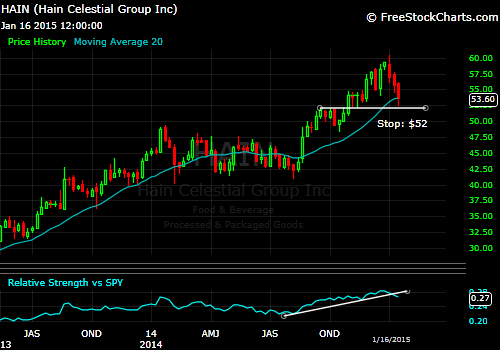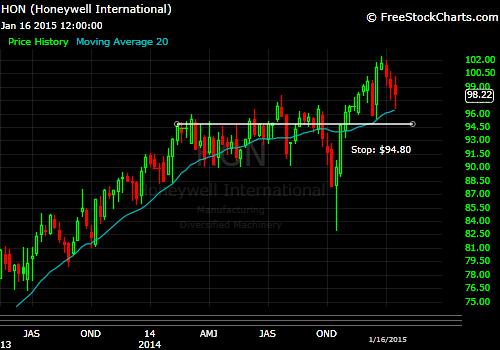For this weekend's review I would like to share how I deal with a corrective market. I will note that anytime in the past 2 years that I have blogged about a "correction" or mentioned caution, it has almost exactly marked the low in prices before they ripped back to new highs. So keep that in mind :)
But if this time is different....
I try to treat all corrections the same. The most important thing is to stick to the strategy as that will allow me to make the most correct decisions when stress is at its highest. Taking losses in the market hurts. No matter who you are, it doesn't feel good to be proven wrong and worse yet you had to pay money to find that out. This fear of loss can create a lot of mixed emotions and incorrect decisions. If you are investing money in the market, it will happen often. Your positions will be in the red a lot. So if this is going to be a common and recurring event we better have a way to move through it as easily as possible. This is how I attempt to manage corrections in the market.
The four things I try to be mindful of during corrections are:
1. Manage my current holdings
2. Raise cash to reduce overall market exposure
3. Build a watchlist of stocks behaving well
4. Have Patience
The most important thing to do during a market correction is to manage your current holdings. Everything else comes secondary to this. You cannot allow an acceptable loss to become a large loss. To do this you need to focus on your predetermined stops and execute your strategy.
Exiting Bank of America (BAC)
Along with the rest of the Financials, BAC rolled over hard this week and violated my stop level. The stock has been beaten the last 2 weeks, so a bounce may be likely. But we don't wait around for hopeful outcomes. Our stop was triggered, we take our loss and move on.
The next part of managing your holdings is to identify which positions are behaving weakly and nearing their stop levels.
HAIN
GS
Also we especially want to pay attention to the positions that are showing strength and bucking the overall weakness. These have the best chance to be leaders when the market turns for the better.
Traits I look for here are stocks continuing to set new highs and those holding above a key breakout level. Fortunately most of our holdings are fitting into this category and acting like leading stocks.
PCG
PPG
UNH
DIS
TLT
BMY
IP
BRKB
SBUX
UPS
The last part about position management is to note which stocks are trading with the general market and performing inline. Watch these because they could turn for the better or worse.
HON
NKE
TWX
Okay so we know where we stand with our holdings should further weakness occur. Now we need to be vigilant for when we need to execute exits for those weakening positions. As the market takes out our weakest holdings, our cash position will rise therefore reducing our overall market exposure.
Reducing risk is the name of the game for surviving corrections. Selling weak positions and raising cash is a very effective strategy for risk management and works much better than attempting to time the lows in a downtrend. Continually buying in the hope that you will pick the bottom will eat up your account through overtrading. Overtrading during poor market environments is one of the major issues that traders have.
4 out of 5 stocks trade in the direction of the general market. I don't try to fight that wave and prefer to be more aggressive during favorable times. Some will disagree with me when it comes to using the overall market as a filter for my individual positions. Many believe that you can pick market winners in all environments. This may be true but I prefer to swim with the current and not against it. Investing is hard enough, let alone ignoring the gravitational pull of the indexes on your holdings.
By using a simple trend filter on the overall market can help keep you only adding risk during favorable trends and protects you from increasing exposure during a downtrending environment. Successful investing is not a sprint, you don't have to always be aggressively in the market. I choose to remain patient and keep my risk exposure aligned with the dominant market trend.
This week's closing trend signal suggests we are still in an uptrending market despite the recent volatility. The corrective period we have seen should still be viewed in the context of a larger uptrend that remains intact.
SP500 weekly
In addition to what my holdings are doing during a correction in the market, I like to know which stocks on the watchlist are acting the best also. Taking note of the strongest performing stocks will prove helpful once the correction ends as they will likely begin to lead higher on the next advance. A few names that are of particular interest to me currently are:
BIIB
INTC
BA
PFE
The central binding theme to this process is PATIENCE. You must be able to exercise patience when you approach the market and managing risk. You must have patience to continue to let your existing positions run and you must have patience to simply observe a downtrend without lunging at every wiggle in the market. Build a list of the stocks performing the best and wait for the market to regain its health.
When the correction finally ends your portfolio should only be left with the strongest stocks in the market. These survivors are the ones that eventually become the big winners. By eliminating the weakest stocks and raising cash you can then position toward other stocks on your watchlist that are displaying exceptional performance.
Your portfolio should become stronger and stronger with the corrections that come and go. It is for that reason I have learned that corrections in the market are to be embraced, not feared. What is there to fear about eliminating the weak and acquiring the strong?





















No comments:
Post a Comment